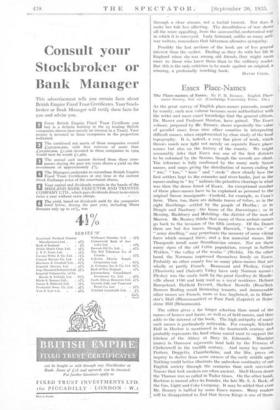Essex Place-Names
As the great survey of English place-names proceeds, county by county, each new volume becomes more authoritative with the wider and more exact knowledge that the general editors, Dr. Mawer and Professor Stenton, have gained. The Essex volume, prepared by Mr. Reaney, shows repeatedly the value of parallel cases from nine other counties in interpreting difficult names, when supplemented by close study of the local topography. It is, indeed, a very fine piece of work, which throws much new light not merely on separate Essex place- names but also on the history of the county. We might reasonably infer that Essex was one of. the first districts to be colonised by the Saxons, though the records are silent. The inference is fully confirmed by the many early Saxon names, and maps giving the distribution of names ending in " wic," " tun," " ham " and " stede " show clearly how the first settlers kept to the estuaries and river-banks, just as the names ending in ley " indicate the primitive clearings in what was then the dense forest of Essex. An exceptional number of these place-names have to be explained as personal to the original Saxon immigrants—Canfield, for example, as Cana's farm. Then, too, there are definite traces of tribes, as in the eight Roothings—settled by the people of Hrotha ; or in Dengie and Danbury—the home of the Daenningas ; or in Messing, Mashbury and Matching—the district of the men of Maecca. Mr. Reaney thinks that many of these archaic names go back to the invasion of the fifth century. Of the Danes there are but few traces, though Harwich, " here-wie " or " army dwelling," may perpetuate the memory of some viking force which camped there, and a few manorial names like Thurgoods recall some Scandinavian owner. Nor are there many signs of the old Celtic population, except in Saffron Walden, " the valley of the wealas " (Welsh). On the other hand, the Normans impressed themselves firmly on Essex. Probably no other county has so many place-names that are wholly or partly French. Beaumont and Pleshey, Grays (Thurrock) and (Salcott) Virley have only Norman names Pleshey was the castle built by the great Geoffrey de Mande- ville about 1100 and long used as a royal residence. Helions Bumpstead, Hatfield Peverel, Shellow Bowells (Bouelles), Berners finding recall Domesday tenants, and innumerable other names are French, more or less Anglicised, as in Blasts- ster's Hall (Blancmoustier) or Poor Park (Lepuier) or Brim- stone Hill (Briaunzoun).
The editor gives a far longer selection than usual of the names of houses and farms, as well as of field-names, and thus adds to the interest of the book. The high antiquity of many such names is particularly noticeable. For example, Kitchen Hall in Harlow is mentioned in the fourteenth century and probably represents the land whose rental went to support the kitchen of the Abbey at Bury St. Edmunds. Minchins (nuns) in Dunntow represents land held by the Prioress of Clerkenwell . in the twelfth century. And many lay names, Porters, Doggetts, Chamberlains, and the like, prove on inquiry to derive from some owners of the early middle ages. Nothing could better illustrate the unbroken continuity of our English society through the centuries than such survivals. Names that look modern arc often ancient. Shell Haven down the Thames was so called in Tudor times. On the other hand, Beckton is named after its founder, the late Mr. S. A. Beck, of the Gas, Light and Coke Company. It may be added that even Mr. Reaney is baffled by some Essex names. Many readers will be disappointed to find that Seven Kings is one of them- If seven Saxon kings did not meet there,' as local tradition leas it, the name may stand for " Seofecingas," the settlement of the people of Seofeca whose name is preserved in the Berkshire Seacourt. But the great majority of the place- names are reasonably interpreted, and the introduction summing up the conclusions to be derived from this mass of evidence is most valuable.







































 Previous page
Previous page